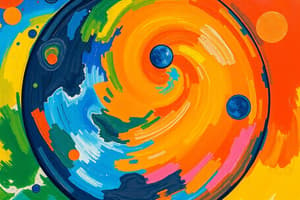Podcast
Questions and Answers
What is the approximate age of the Earth?
What is the approximate age of the Earth?
4.54 billion years
Which gases constitute the atmosphere of the Earth? (Select all that apply)
Which gases constitute the atmosphere of the Earth? (Select all that apply)
- Nitrogen (correct)
- Hydrogen
- Oxygen (correct)
- Carbon Dioxide (correct)
How many continents are generally accepted to exist on Earth?
How many continents are generally accepted to exist on Earth?
Seven
Which continent has the largest area and population?
Which continent has the largest area and population?
Africa has more terrain covered by deserts than any other continent.
Africa has more terrain covered by deserts than any other continent.
What is the highest mountain in Africa?
What is the highest mountain in Africa?
Which sea is known as the largest lake with saltwater?
Which sea is known as the largest lake with saltwater?
What is the primary river system in North America?
What is the primary river system in North America?
What is the primary feature of Australia?
What is the primary feature of Australia?
What percentage of the Earth is covered by land and water?
What percentage of the Earth is covered by land and water?
What does the term 'glacier' refer to?
What does the term 'glacier' refer to?
The theory of Plate Tectonics states that continents are fixed.
The theory of Plate Tectonics states that continents are fixed.
What was the name of the supercontinent that existed millions of years ago?
What was the name of the supercontinent that existed millions of years ago?
Which of these rivers is the longest in Africa?
Which of these rivers is the longest in Africa?
Flashcards are hidden until you start studying
Study Notes
Physical Characteristics of Earth
- Earth is the fifth largest and third planet from the Sun in the solar system, estimated to be 4.54 billion years old.
- Composed of a multi-layered atmosphere made up of 78% nitrogen, 20.95% oxygen, and 0.039% carbon dioxide, along with water vapor.
- Atmospheric layers thin with altitude and protect Earth from harmful ultraviolet rays, solar radiation, and temperature extremes.
Continents
- The continents are large land masses separated by bodies of water, traditionally recognized as seven:
- Asia
- Europe
- Africa
- North America
- South America
- Australia
- Antarctica
Asia
- Largest continent by area (17,128,500 square miles) and population, covering almost one-third of Earth's land.
- Divided into five major regions: East Asia, South Asia, Southeast Asia, West Asia, and North Asia (Central Asia).
- Home to diverse geographical features including mountains, active volcanoes, plateaus, valleys, plains, peninsulas, and islands.
Africa
- Second largest continent, spanning 11,677,239 square miles.
- Rich in deserts, forests, and large plateaus; one-tenth is desert, predominantly the Sahara.
- Notable bodies of water include the longest lake, Lake Tanganyika (676 km) and Lake Victoria, which is crucial for the Nile River.
- Home to Mount Kilimanjaro, the continent's highest peak at 19,341 feet (5,895 meters).
Europe
- Birthplace of Western civilization; occupies about 1/15th of Earth's land area.
- Major geographic regions include:
- Northwest Mountain
- Great European Plains
- Central Uplands
- Alpine Mountain System
- Features the Caspian Sea, the largest saltwater lake, and the Mediterranean Sea, a historical trade route.
North America
- The third largest continent, bordered by the Arctic Ocean to the north and tropical regions to the south.
- Home to significant waterways such as the Mackenzie River and St. Lawrence River, as well as the Great Lakes.
- Niagara Falls is a major hydropower source, and the Yosemite Falls is North America's tallest waterfall.
South America
- Fourth largest continent, twice the size of the United States.
- Characterized by rich mineral deposits, fertile lands, and extensive rainforests, primarily located in the tropics.
- Major geographic features include the Amazon River and Rio de la Plata systems.
Australia
- The smallest continent but the sixth-largest country in the world.
- Composed of three primary regions:
- Eastern Highlands: Fertile area conducive to agriculture.
- Central Lowlands: Mostly arid with scarce inhabitants.
- Western Plateau: Predominantly desert region.
Antarctica
- Closest to the South Pole, it's the coldest and driest continent.
- Home to the Transantarctic Mountains, which reach heights of 4,900 meters.
- Divided into East and West Antarctica, featuring diverse landforms and ice caps.
Landforms and Water Bodies
- Earth's surface is 30% land and 70% water.
- Major landforms include plains, mountains, hills, plateaus, deserts, and islands.
- Key water bodies include oceans, rivers, lakes, gulfs, seas, and bays, critical for human civilization and agriculture.
Glacial Impact on Earth's Topography
- Glaciers, significant ice masses, were active during the Pleistocene epoch, contributing to landform changes.
- Lambert Glacier in Antarctica is the world’s largest glacier, measuring 400 km in length and 2,500 m deep.
Theories of Earth's Physical Changes
- Continental Drift: Introduced by Alfred Wegener, suggesting the original supercontinent Pangaea split and drifted apart.
- Plate Tectonics: Highlights the movement of Earth's lithospheric plates due to heat from below the surface, driving continental drift and seismic activity.
Gondwanaland
- A former landmass connecting present-day South America, Africa, Australia, and Antarctica, evidenced by shared fossils like Glossopteris and Mesosaurus found across these continents.
Studying That Suits You
Use AI to generate personalized quizzes and flashcards to suit your learning preferences.




